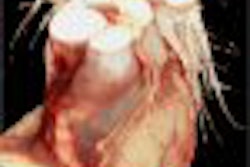The contrast media industry is poised to take advantage of new Medicare payment codes that go into effect in July. The resulting higher payments will partly offset a decline seen in some contrast media prices in recent years.
U.S. legislation passed last December directed the Health Care Financing Administration (HCFA) to create new ambulatory payment classifications (APCs) for contrast-enhanced diagnostic procedures. The law also defines contrast agents as drugs under Medicare rules, meaning they will in most cases have pass-through status as new drugs, allowing reimbursement at 95% of the average wholesale price. The legislation clarifies the payment scheme for contrast agents and contrast-enhanced procedures, allowing Medicare to pay separately for procedures with and without contrast.
"This could be good for the development of new contrast agents," said Jack Slosky, Ph.D., senior director of professional and payor relations for DuPont Pharmaceuticals of North Billerica, MA. "The caution is that legislation is just the first step."
APCs are similar to the diagnosis-related groups (DRGs) for inpatient services, and went into effect last year. They are the result of a HCFA-led effort to shift Medicare payments from a fee-for-service structure to bundled reimbursements under the hospital outpatient prospective payment system (HOPPS). The original HOPPS legislation that became effective last August did not allow separate billing for contrast-enhanced tests, and drew the ire of the contrast media industry.
Although payments were usually approved before HOPPS, they weren’t standardized. Under HOPPS, Medicare was directed to base most diagnostic imaging classifications on the modality, regardless of whether contrast media were used. Using contrast media increases the cost of a procedure, and the industry feared hospitals and radiologists would be reluctant to use the agents.
December's legislation was welcomed by manufacturers. DuPont is one company that stands to benefit from the new codes, as it awaits what it expects is imminent approval of its ultrasound contrast agent, Definity.
The worldwide market for contrast media is expected to reach $4.2 billion by 2006, up from $3.4 billion in 1999, say analysts at market research group Frost & Sullivan of San Jose, CA. But x-ray contrast media prices continue to drop, slowing growth and development of new agents.
"The fear was that if there was no additional payment for the more expensive contrast agents, that it would have led to a negative atmosphere in the industry," said Robert Dell'Elmo, manager of reimbursement services for Bracco Diagnostics of Princeton, NJ.
Approximately 70% of CT procedures use contrast, according to Gail Prochaska, vice president of vendor sales for IMV Medical Information Division (formerly Technology Marketing Group) of Des Plaines, IL. She said 37% of MRI procedures use contrast.
"But we won't be able to see the effects of the new APCs until we count procedures next year," Prochaska said.
An industry group has been working with HCFA to set up APCs that would facilitate billing for radiological procedures with or without contrast agents. The Medical Imaging Contrast Agent Association (MICAA), which comprises 10 top manufacturers, has proposed some two dozen new APCs for x-ray, CT, MRI, and echocardiography, both with and without contrast media.
"Under MICAA, we've been working with HCFA to establish APCs and payment amounts as well, so there may be some relief for contrast users as of July," Dell'Elmo said.
Dr. Richard Cohan is a neuroradiologist at the University of Michigan in Ann Arbor, who is an expert in iodinated contrast agents and MRI contrast. He said his university practice would likely be unaffected by the new APCs.
"It may be more of an issue for private-practice (radiologists), but it probably would not be important for us, because we just do what is necessary in terms of using contrast," Cohan said. "If we are able to bill more of it, it might help reimbursement."
Another university-based contrast media expert agreed. "For any contrast user the decision to use contrast media is not primarily based on whether there will be reimbursement," said Dr. Robert Brasch, professor of radiology and director of the Center for Pharmacology and Molecular Imaging in the Department of Radiology at the University of California, San Francisco. "However, hospitals have been using (contrast media) to their own disadvantage. This kind of legislation might be the right thing to do, because it recognizes (contrast media) as an important adjunct to the exam and reimburses for added costs."
Reimbursement should be adequate to allow R&D for new and better contrast media, said Brasch, whose lab develops new concepts for contrast media, and new applications for existing products.
"There absolutely should be a system that allows new contrast media to be developed, and that makes a profit for companies," he said.
"Cost containment will continue," said Bracco's Dell'Elmo, "but the outcome is dependent upon the ability of medical professionals to organize to present a strongly documented case to HCFA on how to roll out cost containment."
Slosky of DuPont was skeptical that the APCs would be in place by the July deadline given by HCFA, but Rich White, legislative counsel for MICAA, said his organization is providing HCFA with all the necessary information and support. He believes "it's imminently possible to meet that July deadline."
By Robert BruceAuntMinnie.com contributing writer
April 16, 2001
Related Reading
Radiologists should review checklist before off-label MR contrast use, March 2, 2001
Imaging industry keeps up pressure to fix HCFA payment scheme, July 20, 2000
Click here to post your comments about this story. Please include the headline of the article in your message.
Copyright © 2001 AuntMinnie.com



















